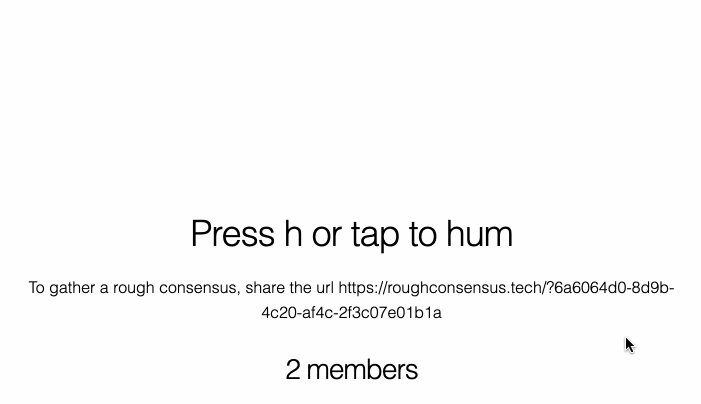Zoom, Humming and Rough Consensus
Like almost everyone right now, I have been working remotely for the last few months due to the current global pandemic. This has also meant that a large portion of every day has been spent on Zoom calls.
Video conference calling is great for lots of things, but one thing I really struggle with is the ability to quickly hash out ideas with a group of people. There is a number of reasons for this, but I find one particular issue is that it is hard to get a read of the room and understand the direction of sentiment. Essentially, I find it hard to get a read of whether some group is broadly for or against a particular idea or proposal.
Asking for a vote seems too definitive and formal, and can dissuade people from going against the majority. You could establish an anonymous vote, but that faces similar issues of seeming too formal and rigorous for a simple discussion.
To help me with this problem, I built a small tool called Rough Consensus inspired by the workings of the IETF. They have a system, or at least according to what I have read, whereby the idea of rough consensus, having no outstanding serious objections, is more important than agreement, having everyone in 100% alignment. I think this is a really powerful idea and has definitely helped me keep momentum with certain technical discussions that could have quickly met a stalemate.
The whole document is really interesting and well worth a read, but the following sums up the main ideas:
Having full consensus, or unanimity, would be ideal, but we don’t require it: Requiring full consensus allows a single intransigent person who simply keeps saying “No!” to stop the process cold. We only require rough consensus: If the chair of a working group determines that a technical issue brought forward by an objector has been truly considered by the working group, and the working group has made an informed decision that the objection has been answered or is not enough of a technical problem to prevent moving forward, the chair can declare that there is rough consensus to go forward, the objection notwithstanding.
To reinforce that we do not vote, we have also adopted the tradition of “humming”: When, for example, we have face-to-face meetings and the chair of the working group wants to get a “sense of the room”, instead of a show of hands, sometimes the chair will ask for each side to hum on a particular question, either “for” or “against”.
Rough Consensus provides a simple way for a group of people to “hum” whilst everyone is remotely distributed. Here it is in action.

A demo of Rough Consensus
It does just one thing. When you go to https://consensus.tomgamon.com it will generate you a private room with it’s own UUID, you can share that link with anyone and they will end up in the same room as you. You can then hold h or hold your finger on your screen on mobile to start “humming”. The higher the proportion of people humming in a group, the darker the background color becomes. Thus, the current background color can be used to determine the sentiment of the room. Light green? No one is really feeling it. Dark green? A lot of people are in agreement.
For me, a tool like this can make virtual discussions feel a little less rigid, but I would love to know what you think. I threw it together pretty quickly, but if people find it useful I may spend a little more time on it, so please let me know.